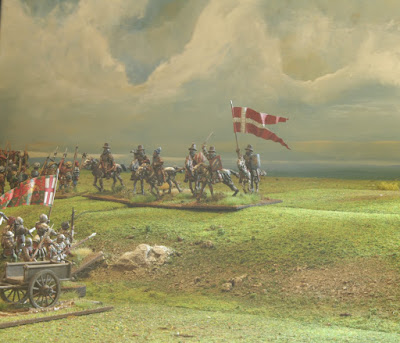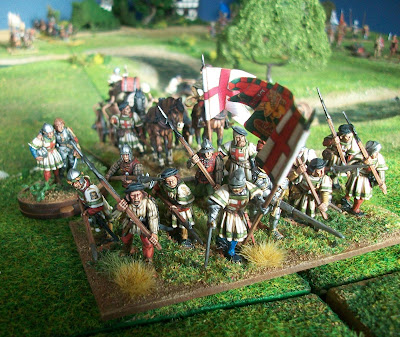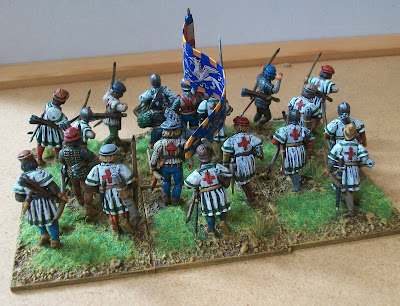This weekend I visited Stuart of Army Royal, http://stuartsworkbench.blogspot.co.uk/, to fight out some more daring actions in Northern France 1513 using our adapted, and ever evolving, Lion Rampant rules. We played three games but were plagued with incredibly bright sunshine for some of the time, I know that is an unusual thing for someone British to say, and then rapidly falling darkness in the afternoons! This limited which games we could photograph. As a result I have chosen two of the games to report on. In the third game we played the "Meeting the Neighbours" scenario from the Lion Rampant rule book and my force, I was playing the French, was completely annihilated to the loss of one unit by Stuart. Such a shame it was already too dark to properly photograph that game.
As with previous reports the photos are all of the actual games and are not staged. Ok so we have added Stuart's superb new backdrop to some of them but none of the figures have been posed or moved. Apologies for any bad lighting, it was tricky to get decent photos a lot of the time. I did not record the games action by action so will summarise what happened in each one, with an obvious bias towards the side I played no doubt. The best way to follow the action is by reading the captions underneath the photos, the images often tell a better tale than I can.
Encounter at Tournehem
The first Scenario we played was loosely based upon an abortive raid on the English column as it marched to Therouanne. The English crossed the river Hem and were met by an advance French force who attempted to draw the English into combat. Skirmishing took place for six hours which was stopped by the arrival of a detachment of English cavalry.
Opposing accounts of the engagement claimed that it was an ambush laid by the other side. The English simply had to break through to reach their billets in Tournehem. The French were ordered by Louis XII to keep the field which was a somewhat vague command, de Piennes interpreted it as to maintain a force in the area to harass the English whereas Bayard favoured a more specific and direct approach of stopping the English. For the game we therefore decided either side could win via aggression, discretion or both.
The forces were as follows (we played with large retinues in this game!)
The French
From a French Ordonnance Company:
2 units of Gendarmes
2 units of Men-at-Arms
2 units of Ordonnance Archers with Bows
Supporting troops:
1 unit of Aventuriers
1 unit of Francs Archer with bows
1 unit of Stradiots
1 unit of Mounted Arquebusiers
The English Column
1 unit of Foot Knights
2 units of Shire Bowmen
1 unit Shire Bill
1 Organ Gun
Accompanying "Almains"
1 unit of Landsknecht Shot
1 unit of Landsknecht Halberdiers
The English Cavalry Relief Force
2 units of Demi-lancers
1 unit of Border Horse
The French started up to 6 inches along the Southern Edge of the table but were allowed to place up to 8 points of troops 8 inches their side of the river as an advance guard. Additionally they could place 4 points of troops in the woods, these were just across the river on one flank.
The English army entered the table on the Northern Edge via normal activation and could move up to full move distance upon the first activation.
We decided the river was relatively shallow and was treated as rough going. It also afforded cover to units in it. It had a ford which due to low lying fog could not be discovered until it was approached. Upon any unit reaching the river the ford was determined as being in the West on a 1-2, Centre on 3-4 and East on 5-6. The ford was passable without detriment to movement
On the third turn after the English had entered the field the English relief entered from the Central Western edge on a 5+ and then a 3+ if it had not yet arrived on the second turn and then automatically on the third turn if it had still not arrived.
The English would gain 1 victory point for each unit that left the table along the Southern edge and for each enemy unit they destroyed or routed. Similarly the French would gain 1 victory point for each enemy unit destroyed or routed and for each friendly unit that remained on the field.
 |
| The French forces advance towards the river, attempting to get into position before the English can. |
 |
| The English take the field and quickly see off a small group of dismounted arquebusiers |
 |
| The fighting develops as the English use Landsknecht shot and Bowmen to drive the French back. |
This was a great game which really gave the feeling of an escalating engagement. Stuart took the English and I played the French. Initially the English continually failed to activate and bring anyone onto the field which meant the French advanced a long way up towards the river. When the English did finally arrive the French Mounted Arquebusiers, who had been placed as an advance force in the woods, were quickly seen off with volleys of arrows from the English Bowmen. On both of the French flanks the Ordonnance archers dismounted and took cover in the shallow water from where they sent a steady stream of arrows at the English. It did not take long for the English to realise the advantage of cover that they river gave and they had soon set up a defensive position along it.
On the French left flank the English Relief arrived. The Border Horse flushed the Ordonnance archers on the left from the riverbed only to themselves be routed by the Francs Archers. The relieving Demi-Lancers entered the river cleverly luring the French Gendarmes into a charge where their heavier armour and barding put them at a disadvantage against the lighter equipped Demi-Lancers. The river really was proving to be a key factor in this engagement.
 |
| The English make it to the river and use the banks as cover in their "shoot out" with the French. |
 |
| The English relief force has arrived and helps to spur on the English infantry. |
 |
| The two forces get uncomfortably near each other, with only a shallow river between them. |
 |
| English Demilancers enter the river... |
 |
| ...and succeed in luring in the French Gendarmes who attack them at a considerable disadvantage in the slippery and rocky terrain. |
 |
| An overview of the developing engagement. |
 |
| The Dismounted French Ordonnance archers in the foreground are making a nuisance of themselves but otherwise the French are steadily giving ground. |
With one unit of their Gendarmes and one unit of mounted archers lost and the other mounted archers struggling to hold their position the French gave ground. They still had some very effective cavalry units left but had realised that engaging the English on the river banks only put them at a disadvantage. The feint had the desired effect and as the English crossed the river in a more disorganised fashion the French counter attacked. Intitially the French counter attack had some success. A unit of Billmen was routed and a unit of archers nearly caught in the open. The archers did make it back to the river bank from where they could more effectively defend against the French horse.
The game ended as an English victory with the French keeping some of their cavalry on the field but having lost more units than the English. The English were also able to get some units off the field which earned them further victory points. The river had played a key part by allowing units to take cover in the initial "fire fights" that had taken place. The difficult terrain also meant that the English could fight the French Heavy Cavalry on equal terms if they were rash enough to engage them in the water.
 |
| The Francs Archers have been seen off so the French horse retreat, knowing that attacking the English while they hold the shallow river will be disastrous. |
 |
| But the retreat turns out to be a feint and the French cavalry attack isolated English units as they cross the water. |
 |
| The over enthusiastic English archers, flushed with victory, have advanced too far and are caught in the open by the vengeful French horse. |
 |
| The archers are driven back to the relative safety of the water where they can fight the French horse more effectively in the rough terrain. |
No Wheels on my Wagon
The second game was again set in Northern France during the summer of 1513. In this fictional scenario, based on the day to day type of attacks that took place in this campaign, an English convoy, supplying the siege at Therouanne, had been shadowed by a larger French force so had formed up in a defensive position. The English had unlimbered their guns along a river bank and sent for aid. The English had to try and escape before being crushed by the French force. The French had to try and destroy the English wagons and guns before aid arrived. The English would try and get the wagons off the table and the organ guns if possible as well. The English could leave by the East or West deployment zones, but all their forces had to leave by the same edge once one unit had left from that edge.
The English defenders deployed in the centre of the table by the river.
English Wagon Column
2 Organ Guns
1 unit of Shire Billmen
1 unit of Shire Longbowmen
Accompanying "Almains"
1 unit of Landsknecht Shot
1 unit of Landsknecht Halberdiers
Plus 2 Wagons. These could be be "picked up" by a unit, it just had to move it into contact with the wagon and declare it was moving it. The wagons then moved as per "The Convoy" Scenario rules in the Lion Rampant rule book. If the wagons were contacted by an enemy before being "picked up" they were considered destroyed.
French Shadowing Retinues
The French forces deployed in the North West and North East zone. They were divided into two separate retinues, each with their own leader.
2 Units of Gendarmes
2 Units of Men-at-Arms
1 Unit of Ordonnance Archers with Bows
1 Unit of Stradiots
2 units of Franc Archers
1 unit of Aventuriers
1 Culverin
English Relief Force
2 Units of Demi-Lancers
1 Unit of Border Horse
Burgundian Auxilliaries
1 Unit of Burgundian Men-at-Arms
1 Unit of Mounted Crossbowmen
The English relief would arrive during the first turn on an 11-12 on 2 dice, then 10+ and so on. We decided exactly where they arrived would not be known from the start and we would dice for the East or West deployment zone when they arrived. A unit would need to role for a move activation to enter and could not attack on the turn it entered the table.
The Relief Force was a separate Retinue with it's own leader.
 |
| The English Guns and Wagons form a defensive position while they await aid. The shadowing French force can be seen in the distance. |
 |
| Outnumbered by the French the English close ranks and, having sent for help, await the arrival of their cavalry. |
 |
| The French forces enter the field hoping to crush the English before help arrives. |
We swapped sides for this game with Stuart now taking the French and myself the English. The English Wagon convoy moved their German Arquebusiers, Archers and Organ Guns into the shallow river for cover while the Billmen attempted to take one of the wagons on and off up the hill to safety. Initially this looked like it might be working as the Stradiots in French service who rode around the top of the hill in a pincer movement were seen off by the English employed Landsknechts. The English success was short lived as the Francs Archers close behind the Stradiots managed to rout the Landsknechts before they could come to grips with them and then sent the Billmen leading the wagon up the hill running in panic. The wagon was abandoned and smashed as it slid back down the slopes.
Meanwhile at the other end of the field the English relief force had arrived. The Border Horse, Burgundian Mounted Crossbowmen and one troop of Demi-Lancers made for the beleaguered Wagon Laager while the Burgundian Men-at-Arms and the other troop of Demi-Lancers surprised the French and attacked them from their flank. This lead to a brief but fierce cavalry melee. Again success seemed to be within reach of the English to start with as the French Men-at-Arms were broken by the initial assault and retreated having been "battered" by the Burgundians. The Burgundians charged a second time, seeing an attack on an already broken enemy as an easy way to earn some English coins and possibly get some noble prisoners to ransom. Unfortunately for them they neglected the more heavily armoured and barded Gendarmes who charged the over enthusiastic Burgundians and sent them fleeing along with the Demi-Lancers who had followed them onto the field.
 |
| Stradiots in French service attempt to encircle the English wagons. |
 |
| The Landsknecht shot in English service have crept up the river banks in an attempt to fire on the dismounted French Ordonnance Archers. |
 |
| The Burgundian Men-at-Arms are more than happy to break spears with the already disordered French Men-at-Arms. |
 |
| With Landsknechts leading the break out, some of the convoy with one of the wagons attempt to escape the field... |
 |
| ...bringing injured men with them, they attempt to climb the hill and escape. |
 |
| The French cavalry have secured the top of the hill and now proceed to ride towards the remaining English, tightening the noose! |
 |
| The French breech-loader on top of the hill has had little part to play in the fight, save a few shots at the English attempting to defend the river. |
In the centre of the field the English defenders who had deployed in the river bed found themselves out ranged by the French who used Franc Archers, Aventuriers and the Ordonnance Bowmen against them. The Border horse did manage to get the remaining wagon and slowly (and I mean really slowly, I rolled four sets of double ones trying to activate these bastards!) bring it across the river in an attempt to get it to safety. The remaining unit of Demi-Lancers and the Mounted Crossbowmen screened the Borderers and the wagon as they attempted to remove it from the field. This led to the Mounted Crossbowmen being routed by the Francs Archers and the Demi-Lancers being bested in a nasty clash of lances in the shallow river as they were charged by the French Gendarmes.
The Borderers did get the wagon off the field but at a terrible cost to the rest of the English force. The Wagon Convoys infantry had been annihilated, one wagon and both the organ guns lost. The relief force hadn't done much better with only the Border Horse getting off the field in good order. Had the Border Horse managed to move at anything greater than a snails pace with the wagon then the Mounted Crossbowmen and Demi-Lancers would have made it to safety with them! In contrast despite some losses both of the French retinues were still in a respectable state although the retinue that had suffered the mounted flank attack had had a bit of a mauling.
A hell of a fight this one, at one point there were charges and counter charges happening all over the table. I think we particularly enjoyed the rule that Burgundian Men-at-Arms will only "Wild Charge" battered units. This is to reflect the fact that in the 1513 campaign they were suspected of only entering the fray when victory was already guaranteed! Amusingly they did have to Wild Charge the battered French Men-at-Arms which meant they were then charged by the Gendarmes with disastrous results.
A great weekends gaming - such a shame that the photos of that third game in which I was completely driven from the field didn't come out well!
 |
| The English Border horse have succeeded in getting the remaining wagon moving. As the hill is occupied by the French they attempt to take it across the river to safety. |
 |
| As the wagon, glimpsed in the bottom left, moves tortuously slowly, the Burgundian Mounted Crossbowmen and English Demi-Lancers attempt to shield it from French attacks. |
 |
| The French are gaining on the wagon. |
 |
| The "Generals"! |





























